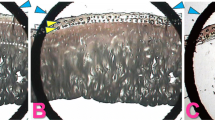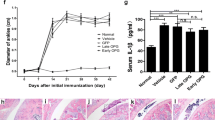Abstract
The reparative responses of articular cartilage after an arthritic insult have not been studied extensively to this day. In the present study, we injected interleukin-1 (IL-1) into knee joints of mice to provoke a mild and transient arthritic insult, and characterized both the catabolic and the subsequent recovery phase. In the catabolic phase, which lasted 2 days after IL-1 injection, proteoglycan (PG) breakdown was profoundly accelerated and PG synthesis was markedly inhibited. Sulfation and polysaccharide synthesis were not affected, yet the number of chondroitin sulfate chains was decreased. The general chondrocyte protein synthesis was not inhibited by IL-1. IL-1 injected every other day for a total of three injections prolonged this catabolic phase and resulted in frank loss of articular cartilage proteoglycans. In the recovery phase, started 3 days after IL-1, PG synthesis was enhanced (1.7 times the normal) and proteoglycans had normal hydrodynamic properties. Remarkably, PG degradation was significantly decreased (approximately 50% of the normal). Zymographic analysis demonstrated enhanced expression of gelatinolytic activities in the extracts of the articular tissues shortly after IL-1 exposure and decreased levels in the recovery phase. We found that the overshoot of PG synthesis and impaired degradation act together to facilitate full cartilage repair 7 days after the last of the three IL-1 injections.
Similar content being viewed by others
References
A. I. Caplan,Cartilage. Sci. Am.521, 82–90 (1984).
N. D. Broom and H. Silyn-Roberts,Collagen-collagen versus collagen-proteoglycan interactions in the determination of cartilage strength. Arth. Rheum.33, 1512–1517 (1990).
T. I. Morales and V. C. Hascall,Factors involved in the regulation of proteoglycan metabolism in articular cartilage. Arth. Rheum.32, 1197–1201 (1989).
A. A. J. van de Loo and W. B. van den Berg,Effects of murine recombinant interleukin 1 on synovial joints in mice: Measurements of patellar cartilage metabolism and joint inflammation. Ann. Rheum. Dis.49, 238–245 (1990).
H. M. van Beuningen, O. J. Arntz and W. B. van den Berg,In vivo effects of interleukin-1 on articular cartilage, Prolongation of proteoglycan metabolic disturbances in old mice. Arth. Rheum.34, 606–615 (1991).
F. A. J. van de Loo, O. J. Arntz, I. G. Otterness and W. B. van den Berg,Protection against cartilage proteoglycan synthesis inhibition by antiinterleukin 1 antibodies in experimental arthritis. J. Rheumatol.19, 348–356 (1992).
F. A. van de Loo, O. J. Arntz, I. G. Otterness and W. B. van den Berg,Modulation of cartilage destruction in murine arthritis with anti-Il-1 antibodies. Agents and Actions39, C211-C214 (1993).
W. B. van den Berg, F. A. J. van de Loo, P. L. E. M. van Lent and L. A. B. Joosten,Mechanism of cartilage destruction in joint inflammation. Agents and Actions39, 49–60 (1993).
M. E. Adams and K. D. Brandt,Hypertrophic repair of canine articular cartilage in osteoarthritis after anterior cruciate ligament transection. J. Rheumatol.18, 428–435 (1991).
G. O. Daumy, J. M. Merenda, A. S. McCall, G. C. Andrews, A. E. Franke, K. F. Geoghegan and I. G. Otterness,Isolation and characterization of biologically active murine interleukin-1α derived from, expression of a synthetic gene in Escherichia coli. Biochem. Biophys. Acta998, 32–42 (1989).
B. J. de Vries, W. B. van den Berg, E. Vitters and L. B. A. van de Putte, Quantitation of glycosaminoglycan metabolism in anatomically intact articular cartilage of the mouse: In vitro and in vivo studies with35S-sulfate,3H-glucosamine and3H-acetate. Rheumatol. Int.6, 27–281 (1987).
R. W. Farndale, D. J. Buttle and A. J. Barrett, “Improved quantitation of sulfated glycosaminoglycans by use of dimethylmethylene blue. Biochem. Biophys. Acta883, 173–177 (1986).
R. L. Y. Sah, A. J. Grodzinsky, A. H. K. Plaas and J. D. Sandy,Effects of tissue compression on the hyaluronate-binding proper ties of newly synthesized proteoglycans in cartilage explants. Biochem. J.267, 8033–808 (1990).
P. M. van der Kraan, E. L. Vitters, N. S. Postma, J. Verbunt and W. B. van den Berg,Maintenance of the synthesis of large proteoglycans in anatomically intact murine articular cartilage by steriods and insulin-like growth factor. 1. Ann. Rheum. Dis.52, 734–741 (1993).
C. Heussen and E. B. Dowdle,Electrophoretic analysis of plasminogen activators in polyacrylamide gels containing sodium dodecylsulfate and copolymerized substrates. Anal. Biochem.102, 196–202 (1980).
A. D. Elbstein,The tunicamycin-useful tools for studies on glycoproteins. Trends Biochem. Sci.6, 219–221 (1981).
G. Venn and R. M. Mason,Biosynthesis and metabolism in vivo of invertebral-disc proteoglycans in the mouse. Biochem. J.215, 217–225 (1983).
K. S. Rostand, J. R. Baker, B. Caterson and J. E. Christner,Isolation and characterization of mouse articular cartilage proteoglycans using preformed CsCl density gradients in the Beckman airfuge. J. Biol. Chem.257, 703–707 (1982).
K. S. Rostand, J. R. Baker, B. Caterson and J. E. Christner,Articular cartilage proteoglycans from normal and osteoarthritic mice. Arth. Rheum.29, 95–105 (1986).
H. P. Benton and J. A. Tyler,Inhibition of cartilage proteoglycan synthesis by interleukin-1. Biochem. Biophys. Res. Commun.154, 421–428 (1988).
T. I. Morales and V. C. Hascall,Effects of interleukin-1 and lipopolysaccharides on protein and carbohydrate metabolism in bovine articular cartilage organ cultures. Conn. Tissue Res.19, 225–275 (1989).
D. Page-Thomas, B. King, T. Stephens and J. T. Dingle,In vivo studies of cartilage regeneration after damage induced by catabolin/interleukin-1. Ann. Rheum. Dis.50, 75–80 (1991).
R. A. Stockwell,The interrelationship of cell density and cartilage thickness in mammalian articular cartilage. J. Anat.109, 411–421 (1971).
S. Chandrasekhar, A. K. Harvey and P. S. Hrubey,Intra-articular administration of interleukin-1 causes prolonged suppression of cartilage proteoglycan synthesis in rats. Matrix11, 1–10 (1992).
F. Boussidan and A. M. Nahir,Altered chondrocytic oxidative metabolism during the restoration of depleted intercellular matrix. J. Exp. Pathol (Oxford)71, 195–402 (1990).
A. J. Fosang, J. A. Tyler and T. E. Hardingham,Effect of interleukin-1 and insulin like growth factor-1 on the release of proteoglycan components and hyaluronan from pig articular cartilage in explant culture. Matrix11, 17–24 (1991).
C. Hughes, G. Murphy and T. E. Hardingham,Metalloproteinase digestion of cartilage proteoglycan. Pattern of cleavage by stromelysin and susceptibility to collagenase. Biochem. J.279, 733–739 (1991).
J. D. Sandy, R. E. Boynton and C. R. Flannary,Analysis of catabolism of aggregan in cartilage explants by quantitation of peptides from the three globular domains. J. Biol.266, 8683–8685 (1991).
V. Lefebvre, C. Peeters-Joris and G. Vaes,Production of gelatin-degrading matrix metalloproteinases (‘type IV collagenases’) and inhibitors by articular chondrocytes during their dedifferentiation by serial subcultures and under stimulation by interleukin-1 and tumor necrosis factor α. Biochim. Biophys. Acta1094, 8–18 (1991).
A. J. P. Docherty and G. Murphy,The tissue metalloproteinase family and the inhibitor TIMP: a study using cDNAs and recombinant proteins. Ann. Rheum. Dis.49, 469–479 (1990).
A. C. Arner, and M. A. Pratta,Independent effects of interleukin-1 on proteoglycan breakdown, proteoglycan synthesis, and prostaglandin E2 release from cartilage in organ culture. Arth. Rheum.32, 288–297 (1989).
Author information
Authors and Affiliations
Rights and permissions
About this article
Cite this article
van de Loo, A.A.J., Arntz, O.J., Otterness, I.G. et al. Proteoglycan loss and subsequent replenishment in articular cartilage after a mild arthritic insult by IL-1 in mice: Impaired proteoglycan turnover in the recovery phase. Agents and Actions 41, 200–208 (1994). https://doi.org/10.1007/BF02001917
Received:
Accepted:
Issue Date:
DOI: https://doi.org/10.1007/BF02001917




